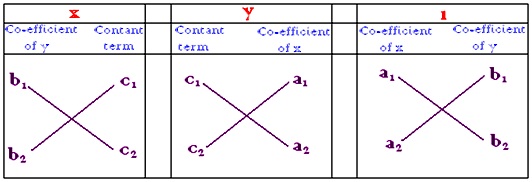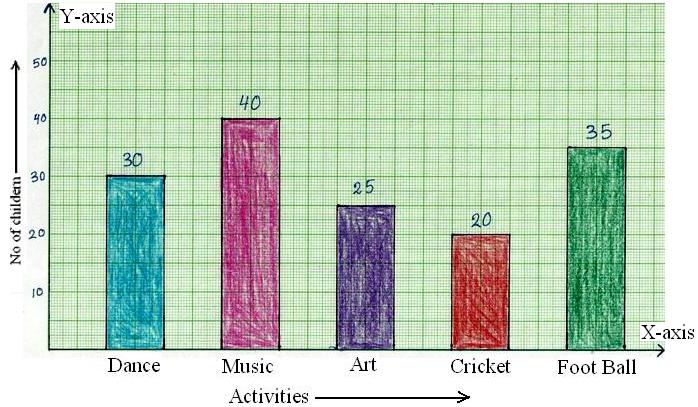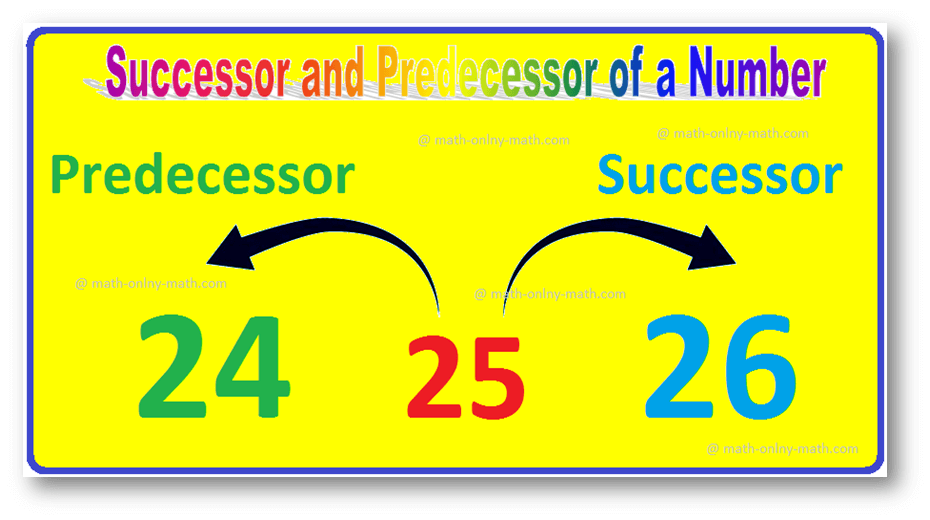Subscribe to our ▶️ YouTube channel 🔴 for the latest videos, updates, and tips.
Home | About Us | Contact Us | Privacy | Math Blog
Cross-Multiplication Method
Here we will discuss about simultaneous linear equations by using cross-multiplication method.
General form of a linear equation in two unknown quantities:
ax + by + c = 0, (a, b ≠ 0)
Two such equations can be written as:
a₁x + b₁y + c₁ = 0 ----------- (i)
a₂x + b₂y + c₂ = 0 ----------- (ii)
Let us solve the two equations by the method of elimination, multiplying both sides of equation (i) by a₂ and both sides of equation (ii) by a₁, we get:
a₁a₂x + b₁a₂y + c₁a₂ = 0
a₁ a₂x + a₁b₂y + a₁c₂ = 0
Subtracting, b₁a₂y - a₁b₂y + c₁a₂ - c₂a₁ = 0
or, y(b₁ a₂ - b₂a₁) = c₂a₁ - c₁a₂
Therefore, y = (c₂a₁ - c₁a₂)/(b₁a₂ - b₂a₁) = (c₁a₂ - c₂a₁)/(a₁b₂ - a₂b₁) where (a₁b₂ - a₂b₁) ≠ 0
Therefore, y/(c₁a₂ - c₂a₁) = 1/(a₁b₂ - a₂b₁), ------------- (iii)
Again, multiplying both sides of (i) and (ii) by b₂ and b₁ respectively, we get;
a₁b₂x + b₁b₂y + b₂c₁ = 0
a₂b₁x + b₁b₂y + b₁c₂ = 0
Subtracting, a₁b₂x - a₂b₁x + b₂c₁ - b₁c₂ = 0
or, x(a₁b₂ - a₂b₁) = (b₁c₂ - b₂c₁)
or, x = (b₁c₂ - b₂c₁)/(a₁b₂ - a₂b₁)
Therefore, x/(b₁c₂ - b₂c₁) = 1/(a₁b₂ - a₂b₁) where (a₁b₂ - a₂b₁) ≠ 0 -------------- (iv)
From equations (iii) and (iv), we get:
x/(b₁c₂ - b₂c₁) = y/(c₁a₂) - c₂a₁ = 1/(a₁b₂ - a₂b₁) where (a₁b₂ - a₂b₁) ≠ 0
This relation informs us how the solution of the simultaneous equations, co-efficient x, y and the constant terms in the equations are inter-related, we can take this relation as a formula and use it to solve any two simultaneous equations. Avoiding the general steps of elimination, we can solve the two simultaneous equations directly.
So, the formula for cross-multiplication and its use in solving two simultaneous equations can be presented as:
If (a₁b₂ - a₂b₁) ≠ 0 from the two simultaneous linear equations
a₁x + b₁y + c₁ = 0 ----------- (i)
a₂x + b₂y + c₂ = 0 ----------- (ii)
we get, by the cross-multiplication method:
x/(b₁c₂ - b₂c₁) = y/(c₁a₂ - c₂a₁) = 1/(a₁b₂ - a₂b₁) ---------- (A)
That means, x = (b₁c₂ - b₂c₁)/(a₁b₂ - a₂b₁)
y = (c₁a₂ - c₂a₁)/(a₁b₂ - a₂b₁)
Note:
If the value of x or y is zero, that is, (b₁c₂ - b₂c₁) = 0 or (c₁a₂ - c₂a₁) = 0, it is not proper to express in the formula for cross- multiplication, because the denominator of a fraction can never be 0.
From the two simultaneous equations, it appears that the formation of relation (A) by cross-multiplication is the most important concept.
At first, express the co-efficient of the two equations as in the following form:
Now multiply the co-efficient according to the arrow heads and subtract the upward product from the downward product. Place the three differences under x, y and 1 respectively forming three fractions; connect them by two signs of equality.
Worked-out examples on simultaneous linear equations by using cross-multiplication method:
1. Solve the two variables linear equation:
8x + 5y = 11
3x – 4y = 10
Solution:
On transposition, we get
8x + 5y – 11 = 0
3x – 4y – 10 = 0
Writing the co-efficient in the following way, we get:
Note: The above presentation is not compulsory for solving.
By cross-multiplication method:
x/(5) (-10) – (-4) (-11) = y/(-11) (3) – (-10) (8) = 1/(8) (-4) – (3) (5)
or, x/-50 – 44 = y/-33 + 80 = 1/-32 – 15
or, x/-94 = y/47 = 1/-47
or, x/-2 = y/1 = 1/-1 [multiplying by 47]
or, x = -2/-1 = 2 and y = 1/-1 = -1
Therefore, required solution is x = 2, y = -1
2. Find the value of x and y by using the using cross-multiplication method:
3x + 4y – 17 = 0
4x – 3y – 6 = 0
Solution:
Two given equations are:
3x + 4y – 17 = 0
4x – 3y – 6 = 0
By cross-multiplication, we get:
x/(4) (-6) – (-3) (-17) = y/(-17) (4) – (-6) (3) = 1/(3) (-3) – (4) (4)
or, x/(-24 – 51) = y/(-68 + 18) = 1/(-9 – 16)
or, x/-75 = y/-50 = 1/-25
or, x/3 = y/2 = 1 (multiplying by -25)
or, x = 3, y = 2
Therefore, required solution: x = 3, y = 2.
3. Solve the system of linear equations:
ax + by – c² = 0
a²x + b²y – c² = 0
Solution:
x/(-b + b²) = y/(- a² + a) = c²/(ab² - a²b)
or, x/-b(1 - b) = y/- a(a - 1) = c²/-ab(a - b)
or, x/b(1 - b) = y/a(a - 1) = c²/ab(a - b)
or, x = bc²(1 – b)/ab(a – b) = c²(1 – b)/a(a – b) and y = c²a(a – 1)/ab(a – b) = c²(a – 1)/b(a – b)
Hence the required solution is:
x = c²(1 – b)/a(a – b)
y = c²a(a – 1)/b(a – b)
● Simultaneous Linear Equations
Solvability of Linear Simultaneous Equations
Word Problems on Simultaneous Linear Equations
Word Problems on Simultaneous Linear Equations
Practice Test on Word Problems Involving Simultaneous Linear Equations
● Simultaneous Linear Equations - Worksheets
Worksheet on Simultaneous Linear Equations
Worksheet on Problems on Simultaneous Linear Equations
8th Grade Math Practice
From Cross-Multiplication Method to HOME PAGE
Didn't find what you were looking for? Or want to know more information about Math Only Math. Use this Google Search to find what you need.
Recent Articles
-
Construction of Bar Graphs | Examples on Construction of Column Graph
Jul 30, 25 03:20 PM
Now we will discuss about the construction of bar graphs or column graph. In brief let us recall about, what is bar graph? Bar graph is the simplest way to represent a data. In consists of rectangular… -
Successor and Predecessor | Successor of a Whole Number | Predecessor
Jul 29, 25 12:59 AM
The number that comes just before a number is called the predecessor. So, the predecessor of a given number is 1 less than the given number. Successor of a given number is 1 more than the given number… -
Worksheet on Area, Perimeter and Volume | Square, Rectangle, Cube,Cubo
Jul 28, 25 01:52 PM
In this worksheet on area perimeter and volume you will get different types of questions on find the perimeter of a rectangle, find the perimeter of a square, find the area of a rectangle, find the ar… -
Worksheet on Volume of a Cube and Cuboid |The Volume of a RectangleBox
Jul 25, 25 03:15 AM
We will practice the questions given in the worksheet on volume of a cube and cuboid. We know the volume of an object is the amount of space occupied by the object.1. Fill in the blanks: -
Volume of a Cuboid | Volume of Cuboid Formula | How to Find the Volume
Jul 24, 25 03:46 PM
Cuboid is a solid box whose every surface is a rectangle of same area or different areas. A cuboid will have a length, breadth and height. Hence we can conclude that volume is 3 dimensional. To measur…








New! Comments
Have your say about what you just read! Leave me a comment in the box below. Ask a Question or Answer a Question.